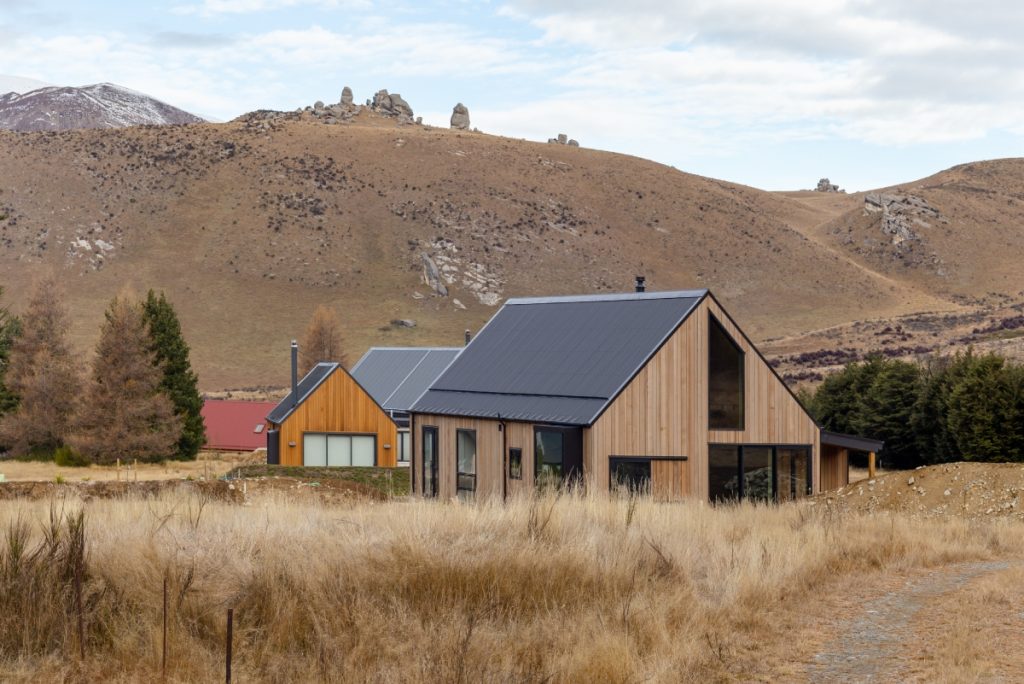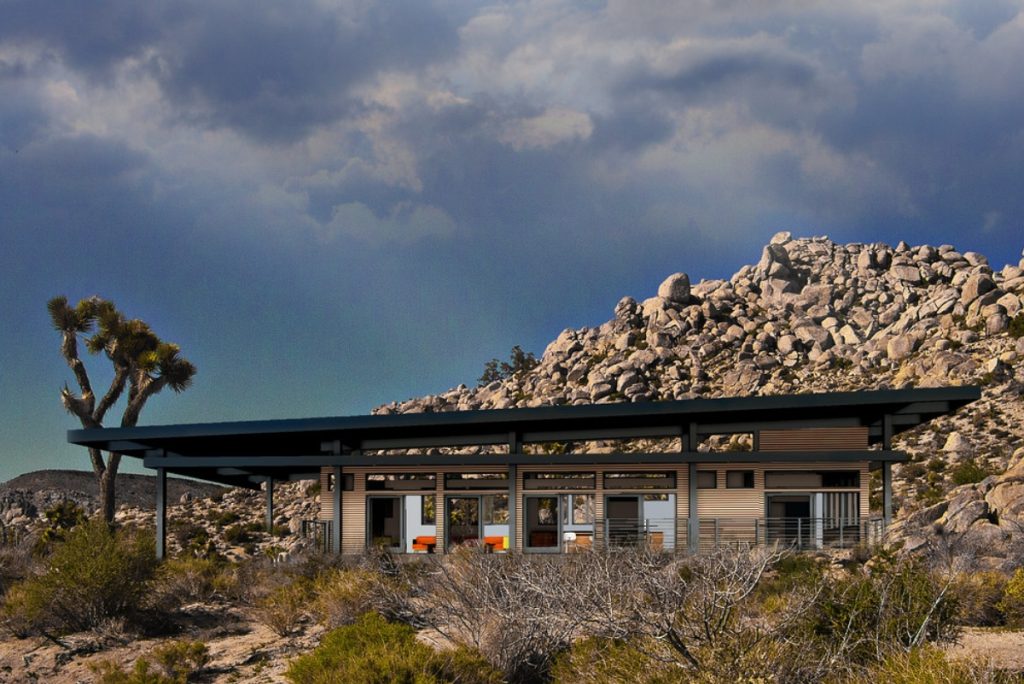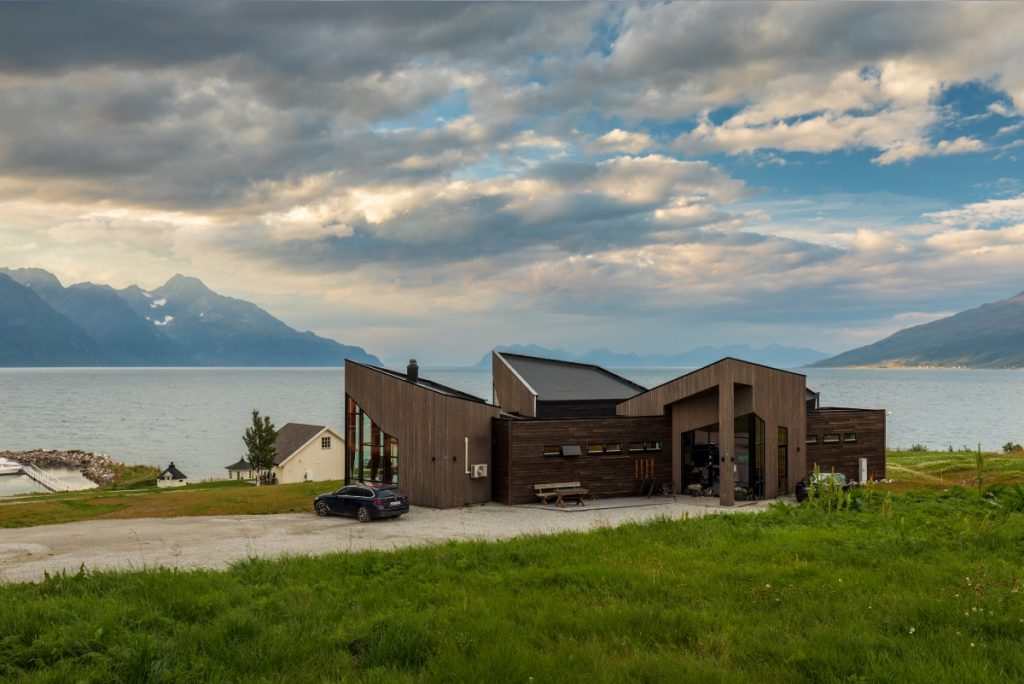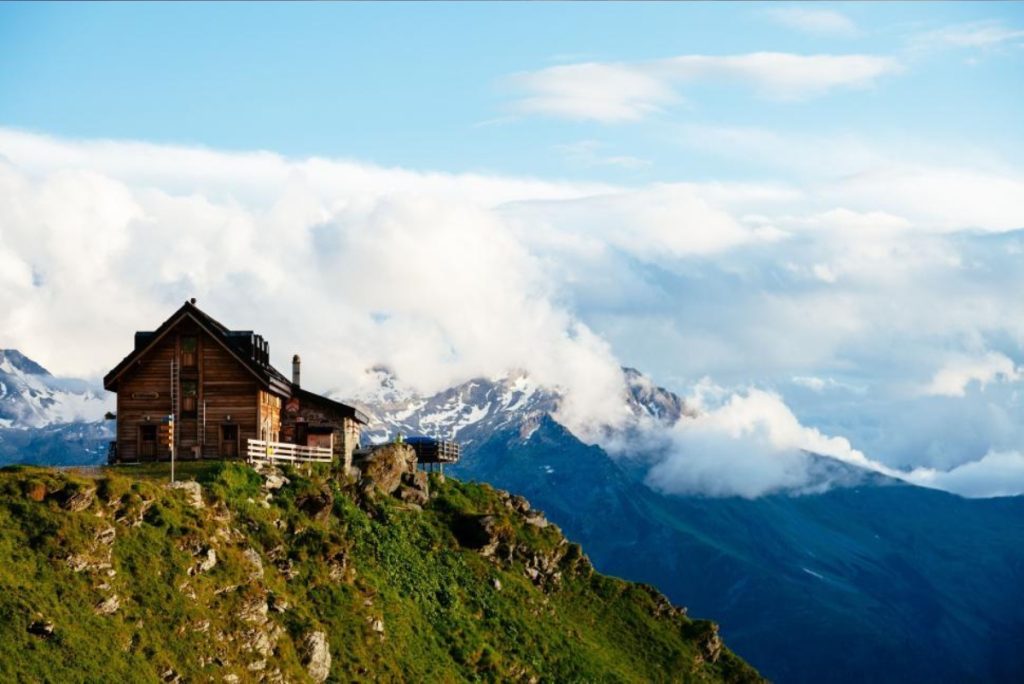Last Updated on January 18, 2024 by teamobn
Modern mountain homes are becoming increasingly popular for their blend of functionality and cozy comfort. These homes offer a unique living experience, combining modern amenities with the natural beauty of mountain landscapes. This article explores the essential elements of a modern mountain home, ensuring a perfect balance between contemporary design and homely warmth.
Contents
- 1 The Essence of a Modern Mountain Home
- 2 Creating a Modern Mountain Home Aesthetic
- 3 Sustainability and Eco-Friendliness
- 4 FAQ for Modern Mountain Home Essentials
- 4.1 What makes a home a ‘modern mountain home’?
- 4.2 How are modern mountain homes environmentally friendly?
- 4.3 What are the key architectural features of a modern mountain home?
- 4.4 Can smart home technologies be integrated into mountain homes?
- 4.5 What is the significance of outdoor living spaces in these homes?
- 4.6 How does local craftsmanship and art contribute to these homes?
- 4.7 What are some water conservation strategies used in modern mountain homes?
- 4.8 Why is native landscaping important in these homes?
- 4.9 Are modern mountain homes suitable for all climates?
- 4.10 Can modern mountain homes be customized to individual preferences?
- 5 Conclusion
The Essence of a Modern Mountain Home
Modern mountain homes represent a harmonious blend of contemporary design and natural serenity. These homes are not just structures; they are sanctuaries that embody a lifestyle, merging the latest architectural innovation with the timeless beauty of the mountains.
Defining the Modern Mountain Home
A modern mountain home is much more than a residence in a hilly region. It’s a concept that unites cutting-edge design with the rustic charm of mountainous landscapes. These homes are characterized by their ability to seamlessly integrate into their natural surroundings while providing all the comforts and conveniences of modern living.
Balancing Nature and Technology
The core of a modern mountain home lies in its ability to balance natural elements with technological advancements. It includes using sustainable materials that blend with the environment and incorporating smart home technologies for enhanced living. The design often features large windows and open spaces, connecting the indoors with the scenic outdoors.
Harmony with the Environment
Modern mountain homes are designed with a deep respect for the natural environment. It involves using locally sourced materials and designs that minimize environmental impact. The architectural layout often follows the land’s natural contours, ensuring that the home not only exists in the landscape but also complements it.
Creating a Modern Mountain Home Aesthetic
Achieving a rustic living space on a hill or scenic cliff can be done by incorporating the right design. Below are essential aspects of a modern mountain home to consider.
Architectural Elements
The architectural elements of a modern mountain home are pivotal in defining its character and functionality. These elements are thoughtfully designed to enhance the connection with nature while ensuring sustainability and comfort.
Use of Natural and Sustainable Materials
In constructing a modern mountain home, using natural materials is not just a design choice but a commitment to sustainability and aesthetic harmony. Stone, wood, and glass are commonly employed for their durability and natural beauty.
Stone offers robustness and a sense of timelessness, while wood brings warmth and a tactile connection to nature. Glass, used in windows and doors, maximizes natural light and offers stunning views of the surrounding landscape.
Moreover, sourcing these materials locally supports regional economies and reduces the carbon footprint associated with transportation. Modern mountain homes achieve an environmentally responsible and visually appealing design by utilizing these materials.
Weather Resilience and Energy Efficiency
The unique architectural design of a modern mountain home considers the challenging weather conditions commonly found in mountainous areas. Architects and builders prioritize features that withstand heavy snowfall, strong winds, and diverse temperature ranges. This resilience is achieved through structural reinforcements, efficient roofing materials, and thoughtful site selection.
Energy efficiency is a parallel priority. Modern mountain homes often incorporate advanced insulation materials, reducing the need for extensive heating during cold months. Solar panels are popular for harnessing renewable energy minimizing reliance on traditional power sources.
Energy-efficient windows provide insulation and reduce the need for artificial lighting, further conserving energy. These elements are essential in creating a modern mountain home that is tough against weather challenges and mindful of energy consumption.
Innovative Design Elements
The innovation in the design of modern mountain homes extends beyond traditional architectural norms, embracing creativity and functionality. These homes often feature unconventional shapes, such as asymmetrical lines or geometric structures, which stand out aesthetically and serve specific purposes. For instance, sloping roofs are visually striking and practical for snow and rain runoff.
The creative use of space is another hallmark of these homes. Architects cleverly utilize every square inch, often with open floor plans that create a sense of spaciousness and fluidity between living areas.
This design approach fosters a communal atmosphere while maximizing available space. Multipurpose areas and hidden storage solutions are common, reflecting a trend towards efficiency and minimalism.
Large windows are a defining feature of modern mountain homes, serving functional and aesthetic roles. They allow for ample natural light, reducing the need for artificial lighting and thereby conserving energy.
More than just windows, these are often floor-to-ceiling glass panels that provide breathtaking panoramic views of the mountainous terrain, effectively bringing the outside world into the home. This connection with the environment is vital, reminding residents of the beauty and serenity of their surroundings.
In essence, the innovative design elements of modern mountain homes are a thoughtful blend of form and function. These designs cater not only to the physical needs of residents but also to their emotional and psychological well-being, creating spaces that are in harmony with the natural world. This innovative approach to architecture makes modern mountain homes not just dwellings but artworks that enhance and respect their natural environment.
The architectural elements of a modern mountain home are a blend of natural materials, resilience against mountain weather, and innovative design. These elements come together to create a home that is not only a place of residence but a piece of art in harmony with its natural surroundings.
Interior Design for Modern Mountain Homes
The interior design of a modern mountain home plays a crucial role in creating a functional and aesthetically pleasing space. It complements the architecture, emphasizing openness, natural elements, and comfort.
Open Floor Plans and Natural Light
The open floor plan is a defining characteristic of modern mountain homes, emphasizing an unobstructed flow between living spaces. This architectural choice transforms the interior into a cohesive and interactive environment.
By merging areas like the kitchen, dining room, and living room, these floor plans encourage family gatherings and social interactions, creating a welcoming and communal atmosphere. The absence of walls or partitions enhances the sense of space, making even smaller homes feel expansive and airy.
Large windows and skylights are integral to these open floor plans, playing a dual role in aesthetics and functionality. They allow abundant natural light to flood the interiors, making spaces appear larger and more open. The strategic placement of these windows ensures that the home is naturally lit at different times of the day, reducing the reliance on artificial lighting and promoting energy efficiency.
The incorporation of natural light also has significant psychological benefits. It can boost mood and increase productivity, creating a lively and positive atmosphere within the home.
Moreover, the expansive windows and skylights provide panoramic views of the mountainous surroundings, blurring the lines between indoors and outdoors. Residents can enjoy the changing landscapes, from snow-capped peaks in winter to lush greenery in summer, all from the comfort of their homes.
Cozy and Modern Furnishing Ideas
The furnishing in a modern mountain home balances comfort and modern aesthetics. Furniture pieces are selected for their functionality, comfort, and ability to complement the natural surroundings. Natural materials like wood, stone, and leather echo the home’s exterior elements. Soft textiles, like woolen throws and plush rugs, add warmth and coziness.
Contemporary art and modern fixtures can be used sparingly to add a touch of sophistication without overpowering the natural charm. The color palette typically includes neutral and earthy tones, drawing inspiration from the mountain landscape. It creates a serene and harmonious environment that resonates with the tranquility of mountain living.
The interior design of a modern mountain home is about creating a harmonious space that resonates with the beauty of its natural setting. It’s a blend of open, light-filled spaces and cozy, comfortable furnishings, all working together to create an inviting home in tune with its environment.
Smart Home Technologies
In modern mountain homes, smart home technologies are pivotal in enhancing comfort, security, and sustainability. These technological advancements are integrated seamlessly to provide a sophisticated yet easy-to-manage living environment.
Automation for Comfort and Security
Smart home systems in modern mountain homes offer unprecedented levels of automation for various home functions. It includes climate control systems that adjust the temperature based on the time of day or the season, ensuring optimal comfort throughout the year.
Lighting systems can also be automated, adjusting brightness based on the time of day or occupancy in a room, adding to the home’s convenience and energy efficiency.
Security is another critical aspect addressed by smart home technologies. Advanced security systems can include motion sensors, surveillance cameras, and smart locks, which can be monitored and controlled remotely. It provides homeowners with peace of mind, knowing their home is secure, whether they are present or away.
Eco-friendly Technology Solutions
Sustainability is a core element in modern mountain homes, and smart home technologies contribute significantly. Systems that monitor and manage energy use, like smart thermostats and energy-efficient appliances, help reduce the home’s carbon footprint. Smart water systems can manage water usage, which is crucial in mountain regions where water might be a limited resource.
Incorporating renewable energy sources like solar panels is also facilitated by smart technology. Homeowners can monitor energy production and consumption in real time, optimizing the use of renewable energy and reducing reliance on traditional power grids.
Entertainment and Connectivity
Modern mountain homes often feature state-of-the-art entertainment systems. Smart TVs, sound systems, and gaming setups are integrated into the home’s design, offering a seamless entertainment experience. High-speed internet connectivity, essential for remote locations, is ensured through advanced networking solutions. This connectivity is vital for entertainment and work-from-home setups, making the home a place for relaxation and productivity.
Health and Wellness Technologies
Health and wellness are increasingly becoming a focus in smart home technologies. Features like air purification and water filtration systems ensure a healthy living environment. Smart lighting can be adjusted to mimic natural light patterns, supporting better sleep and overall wellness. Technology for home fitness, like virtual reality exercise equipment, is also integrated into some homes.
Remote Monitoring and Management
Remote monitoring and management are crucial for homeowners who may not always be on-site. It includes remotely controlling heating, lighting, and security systems via a smartphone or computer. This feature is particularly useful for those who use their mountain home as a vacation property, ensuring it’s always ready and secure for their arrival.
Integration with Personal Assistants
Voice-activated personal assistants, like Amazon Alexa or Google Home, are integrated into the smart home ecosystem. These assistants can control various aspects of the home, from playing music to providing weather updates, all through voice commands. This integration makes daily tasks more convenient and adds an element of futuristic living to the mountain home.
Outdoor Living Spaces
Outdoor living spaces are a fundamental aspect of modern mountain homes, offering a seamless transition between the comfort of the indoors and the beauty of the natural surroundings.
These areas are designed to enhance the mountain living experience, providing spaces for relaxation, entertainment, and enjoying the breathtaking landscape.
Designing Decks and Patios
Decks and patios are common features in modern mountain homes, serving as extensions of the living space. These areas are thoughtfully designed to maximize views and provide comfort. Materials like natural wood or stone are often used to maintain environmental harmony. Features like built-in seating, fire pits, and outdoor kitchens make these spaces ideal for entertaining or enjoying a quiet evening under the stars.
Innovative Landscaping
Landscaping in modern mountain homes goes beyond aesthetic appeal; it’s about creating an ecosystem that complements the natural surroundings. Native plants are chosen for their ability to thrive in the local climate and require minimal maintenance. Water features, like ponds or waterfalls, add a sense of tranquility. Sustainable landscaping practices, such as xeriscaping, can also be crucial in regions with water scarcity.
Outdoor Recreation Amenities
To fully embrace the mountain lifestyle, modern mountain homes often include amenities for outdoor recreation. This might include hiking or biking paths, yoga or meditation spaces, and installations like hot tubs or infinity pools that blend with the landscape. These amenities provide homeowners with direct access to outdoor activities’ health and wellness benefits.
Enhancing Privacy and Comfort
While embracing the outdoors, privacy and comfort are also key considerations. Strategic placement of trees and shrubs can provide privacy from neighbors or passersby. Comfort is enhanced with outdoor heating options, like fireplaces or heated floors, allowing these spaces to be enjoyed year-round, even in cooler mountain climates.
Local Craftsmanship and Art
Incorporating local craftsmanship and art is a significant aspect of modern mountain home design, adding unique character and supporting regional culture. This element brings a sense of authenticity and personalization to the home.
Showcasing Regional Craftsmanship
Modern mountain homes often feature elements made by local artisans. This can include custom furniture, handcrafted decor, and unique architectural details. Local craftsmanship adds a distinctive charm to the home and ensures high quality and durability. It reflects a respect for traditional skills and contributes to preserving local heritage.
Incorporating Local Art
Art from local artists adds vibrancy and personality to modern mountain homes. This can range from paintings and sculptures to textile art that reflects the cultural and natural landscape of the region. Displaying local art beautifies the space and creates a deeper connection to the local community and its cultural background.
Supporting the Local Economy
By choosing local craftsmanship and art, homeowners contribute to the local economy. It supports small businesses and artisans, fostering community growth and sustainability. This approach aligns with many modern mountain home owners who value community involvement and sustainable living practices.
Creating a Unique Home Environment
Integrating local craftsmanship and art turns a modern mountain home into a unique environment that tells a story. Each piece carries the mark of its maker, adding layers of history and meaning to the home. This personal touch makes the home a living space and a curated collection of local culture and artistry.
Sustainability and Eco-Friendliness
Sustainability and eco-friendliness are core principles in the design and functioning of modern mountain homes. These homes are built with a consciousness towards reducing environmental impact and promoting a sustainable lifestyle.
Renewable Energy Sources
The integration of renewable energy sources is a cornerstone in the design of modern mountain homes, emphasizing sustainability and environmental responsibility. These energy solutions are tailored to harness natural resources efficiently, reducing the home’s ecological footprint.
- Solar Energy Utilization: Solar panels are a prevalent choice in modern mountain homes. They are installed on roofs or open areas to capture sunlight, converting it into electricity. This solar power can be used daily for lighting and heating. Solar energy can significantly reduce electricity bills in regions with ample sunlight, allowing homeowners to become energy-independent.
- Wind Energy Systems: In areas with consistent wind patterns, wind turbines are an effective renewable energy source for modern mountain homes. These turbines convert wind energy into electricity, supplementing the home’s energy needs. Smaller, residential-sized turbines are designed to be less intrusive, blending with the home’s architecture while providing a clean energy source.
- Hydro Power Solutions: Micro-hydro power systems can be a viable renewable energy source for homes near streams or rivers. These systems harness the energy of flowing water to generate electricity, offering a constant and reliable power supply. Micro-hydro systems are particularly beneficial in remote mountain areas where other energy sources may be less accessible.
- Geothermal Heating and Cooling: Geothermal systems are another sustainable energy option for modern mountain homes. By tapping into the earth’s consistent underground temperature, these systems provide efficient heating in the winter and cooling in the summer. Geothermal energy is a low-impact and consistent energy source, reducing the home’s reliance on fossil fuels.
Water Conservation Strategies
Water conservation is a critical consideration in the design and operation of modern mountain homes, especially in regions where water is a precious resource. Effective strategies are employed to minimize water usage and maximize its reuse, ensuring sustainability and environmental responsibility.
- Rainwater Harvesting Systems: Rainwater harvesting is common in modern mountain homes. These systems collect rainwater from rooftops, which is then stored in tanks. After proper treatment, the collected water can be used for various non-potable purposes such as irrigation, toilets, and laundry.
- Low-Flow Fixtures: Low-flow fixtures are essential in conserving water without sacrificing performance. These include showerheads, faucets, and toilets that use significantly less water than traditional fixtures. For instance, low-flow toilets can save thousands of gallons of water annually, substantially impacting water consumption.
- Water-Efficient Appliances: Modern mountain homes often feature appliances designed to conserve water. Dishwashers and washing machines with eco-friendly settings use less water and are more energy-efficient. These appliances are good for the environment and cost-effective in the long run, reducing water bills substantially.
- Drought-Resistant Landscaping: Landscaping choices also play a role in water conservation. Many modern mountain homes opt for drought-resistant plants and xeriscaping, which requires little to no irrigation. This approach conserves water and reduces maintenance, providing a natural and sustainable outdoor environment.
- Greywater Recycling Systems: Some modern mountain homes incorporate greywater recycling systems. These systems collect water from showers, sinks, and laundry, then treat and repurpose it for irrigation and other non-potable uses. Greywater recycling is an effective way to reduce water waste and lessen the home’s overall water footprint.
Sustainable Building Materials
Selecting sustainable building materials is fundamental to constructing a modern mountain home. This choice reflects a commitment to environmental stewardship and significantly impacts the home’s sustainability and overall carbon footprint.
- Local Sourcing of Materials: In modern mountain homes, there’s a strong preference for locally sourced materials. Using local stone, wood, or clay reduces transportation emissions, reducing environmental impact. Additionally, local materials blend seamlessly with the surrounding landscape, enhancing the home’s aesthetic appeal.
- Reclaimed and Recycled Materials: Reclaimed wood is popular in modern mountain homes for its rustic charm and sustainability. Wood from old barns, warehouses, or other structures is repurposed, reducing the need for new timber and preserving natural resources. Similarly, recycled metal and glass are used in various aspects of construction, from structural elements to decorative features, adding to the home’s unique character while minimizing waste.
- Bamboo: Bamboo is another sustainable material often used in modern mountain homes. It’s a fast-growing, renewable resource that offers strength and durability comparable to traditional hardwoods. Bamboo’s versatility makes it suitable for flooring, cabinetry, and even structural elements, providing a modern aesthetic while being eco-friendly.
- Eco-Friendly Insulation Choices: Insulation is crucial in modern mountain homes, and sustainable materials are often chosen. Options like cellulose insulation, made from recycled paper, or sheep’s wool insulation offer effective thermal properties while being environmentally friendly. These materials help in maintaining energy efficiency, reducing the need for excessive heating or cooling.
- Non-Toxic and Low-Emission Materials: Modern mountain homes also use non-toxic materials with low volatile organic compound (VOC) emissions. Paints, sealants, and adhesives with low VOC levels contribute to better indoor air quality, ensuring a healthier living environment for the occupants.
Energy Efficiency and Insulation
Optimizing energy efficiency is a crucial aspect of modern mountain home design. It reduces environmental impact, enhances the home’s comfort, and reduces long-term energy costs.
- High-Quality Insulation: High-quality insulation is key to achieving energy efficiency in modern mountain homes. Effective insulation keeps the home warm during the cold mountain winters and cool during the summers. Materials like spray foam, fiberglass, or sustainable options like sheep’s wool insulate walls, roofs, and floors.
- Energy-Efficient Windows and Doors: Modern mountain homes often feature energy-efficient windows and doors. These are designed to minimize heat loss in winter and prevent heat gain in summer. Double or triple-glazed windows with low-emissivity (low-E) coatings are standard. These coatings reflect infrared light, keeping heat inside during winter and outside during summer.
- Thermal Mass Materials: Using thermal mass materials is another strategy in modern mountain homes. Materials like concrete or stone absorb heat during the day and release it slowly when the temperature drops. This natural heating and cooling process contributes to maintaining a stable indoor temperature, reducing the reliance on artificial heating and cooling systems.
- Sealing and Ventilation: Proper sealing is essential to prevent air leaks, a common cause of home energy loss. Modern mountain homes are carefully sealed, especially in areas prone to leaks, such as around windows, doors, and where walls meet roofs. At the same time, adequate ventilation is crucial to maintain indoor air quality. Energy recovery ventilation systems can ensure fresh air while preserving the temperature-controlled environment.
- Smart Thermostats and Controls: Integrating smart thermostats and controls in modern mountain homes further enhances energy efficiency. These systems allow for precise heating and cooling control, adjusting temperatures based on occupancy patterns and preferences. This smart technology ensures that energy is not wasted heating or cooling unoccupied spaces.

FAQ for Modern Mountain Home Essentials
What makes a home a ‘modern mountain home’?
How are modern mountain homes environmentally friendly?
What are the key architectural features of a modern mountain home?
Can smart home technologies be integrated into mountain homes?
What is the significance of outdoor living spaces in these homes?
How does local craftsmanship and art contribute to these homes?
What are some water conservation strategies used in modern mountain homes?
Why is native landscaping important in these homes?
Are modern mountain homes suitable for all climates?
Can modern mountain homes be customized to individual preferences?
Conclusion
Modern mountain homes represent a perfect fusion of functionality, sustainability, and cozy comfort, tailored for those who cherish modern amenities and nature’s serenity. These homes are not just structures; they embody an eco-conscious and technologically advanced lifestyle seamlessly integrated into the breathtaking beauty of mountainous landscapes.






